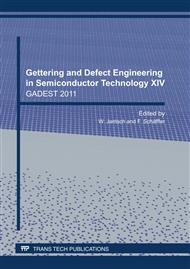p.307
p.313
p.319
p.325
p.331
p.341
p.347
p.353
p.360
Investigation of Defects in Solar Cells and Wafers by Means of Magnetic Measurements
Abstract:
Elaborated characterization tools play an important role for the further improvement of solar material and the development of solar cells. Besides the huge variety of highly advanced methods mainly based on optical and electrical measurements, the direct measurement of surface currents by the detection of their induced magnetic fields has gained less attention. The novel method current-analysis-by-inductive-coils (CAIC) based on an inductive coil detector and is reviewed and compared with already established methods, which are light-beam-induced-current (LBIC) and dark-lock-in-thermography (LIT). The detector reveals complementary information at high resolution. The LIT measurements depicted shunting defects in forward and reverse current. Because of the high spatial resolution of the CAIC measurement technique it was determinable that in some cases the positions of current sinks in the CAIC maps are not corresponding with the microstructure. The analyses of the superpositions reveals macroscopic precipitates like SiC and Si3N4 filaments and clusters as an origin of some of the shunts.
Info:
Periodical:
Pages:
331-340
Citation:
Online since:
August 2011
Authors:
Price:
Сopyright:
© 2011 Trans Tech Publications Ltd. All Rights Reserved
Share:
Citation:



